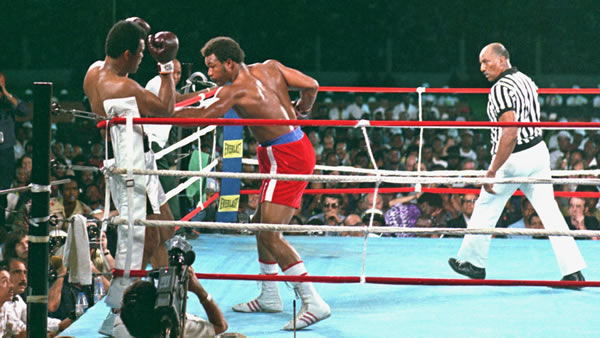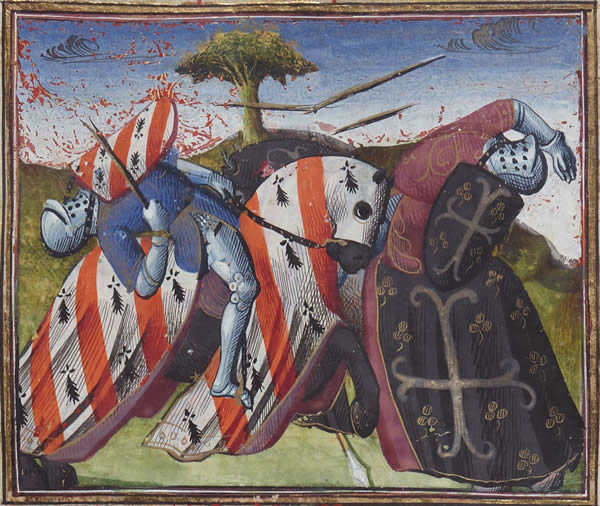800 years before Muhammad Ali defeated George Foreman in Rumble in the Jungle using his “rope-a-dope” technique, one of King Arthur’s knights used a similar technique in a joust gone awry.
The rope-a-dope technique
In the 1974 bout called “Rumble in the Jungle”, Ali scored a knockout in the 8th round against the undefeated George Foreman. After the first round, he employed a tactic of backing up into the ropes, allowing Foreman to land less-damaging hits on his sides and kidneys, and ultimately tiring Foreman out. Ali taunted him throughout the match, whispering to Foreman to hit him some more.
Ali later dubbed it the “rope-a-dope” technique, emphasizing the use of the ropes to support himself and help absorb the blows from his opponent. It wasn’t always successful, but it worked against Foreman. At the very end of the 8th, Ali saw an opening and landed a series of punches that knocked a gassed Foreman down right before the bell.

Although it a very specific tactic for boxing, the concept of luring an opponent to exhaust himself is not new. For example, Sun Tzu instructed,
Offer the enemy a bait to lure him; feign disorder and strike him. When he concentrates, prepare against him; where he is strong, avoid him. Anger and confuse his general. Pretend inferiority and encourage his arrogance. Keep him under a strain and wear him down (1.20-24).
Bors vs. Priadan the Black
That brings us to a duel of Sir Bors, one of King Arthur’s knights of the roundtable. In The Quest for the Holy Grail, a French work written in the first-half of the 13th-century, Bors challenges Priadan the Black to a duel on behalf of an unnamed lady whose lands Priadan was systematically conquering.
These sorts of scenarios are typical in this book.
The dramatic duel begins with the two knights breaking their lances on each other’s shields, eventually dismounting to continue the fight.

As they fought, “Bors found that the knight put up more resistance than he had imagined.” The writer assures us that Bors “knew he was defending a just and legitimate cause, which emboldened him.” He also probably didn’t want to die.
Here is where he employed the rope-a-dope:
Covering himself with his shield, he allowed the rival knight to strike many small blows and wear himself out. After enduring this attack for some time, Bors saw that the knight was out of breath. He then ran at him fast and refreshed, as if he had not yet struck a blow. He attacked relentlessly with his sword and pursued his opponent so fiercely that in a short time the rival could no longer defend himself. He had suffered too many blows and lost too much blood. Seeing his rival thus exhausted, Bors pursued him all the more fiercely until he saw him stumble from side to side and fall backward to the ground. Bors seized the knight’s helmet and pulled so hard that he tore it off his head and tossed it away. He battered Priadan’s head with the pommel of his sword until blood spurted forth, and the rings of the knight’s hauberk were driven into his head. ((This translation comes from the E. Jane Burns transnational (Woodbridge: D. S. Brewer, 2010), 54.173-174, 107-108. Penguin also has a cheaper translation.))
Priadan was beat, but Bors did not kill him, instead threatening to decapitate him. The knight admitted defeat and swore never to harm the unnamed lady again.
One remarkable correlation between Bors’s and Ali’s victories against their opponents was they seemingly employed the rope-a-dope technique mid-bout, realizing it was the viable option. Bors employed it only after he realized Priadan was more than he bargained for once they dismounted and Ali didn’t start employing the ropes against Foreman until the 2nd round. Both our boxing champion and our fictitious knight got a feel for their opponent before employing the defensive technique.
This is the sort of tactical correction that Sun Tzu would have favored, as Bors and Ali offered luring bait, feigned disorder, pretended inferiority, encouraged arrogance, and strained and wore down their opponents.
